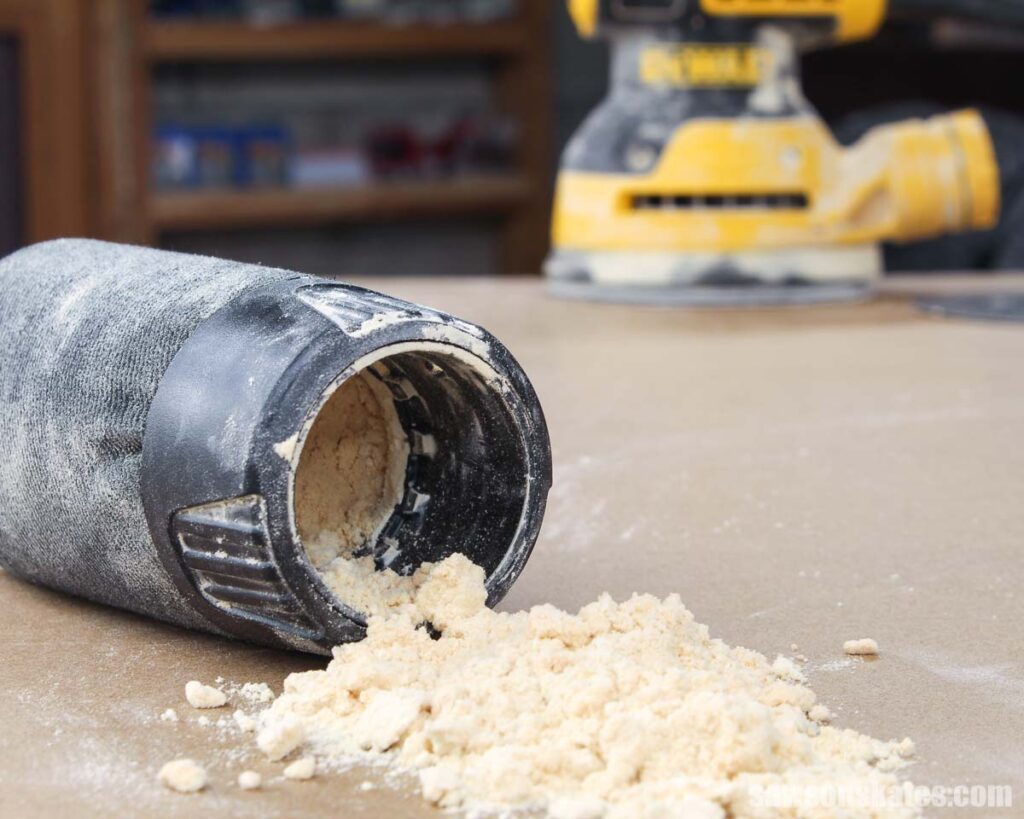How to Get Rid of Sawdust
Sawdust is one of the most annoying things in the world. It gets everywhere, it’s hard to clean up, and it’s just generally a pain. If you’re dealing with sawdust, there are a few things you can do to get rid of it.
- Sweep up the sawdust with a broom or dustpan and dispose of it in the trash
- Vacuum the area with a vacuum cleaner that has a hose attachment to get rid of any remaining sawdust
- Use a damp cloth to wipe down any surfaces that are covered in sawdust
- Place a bowl of vinegar in the room overnight to absorb any lingering odors from the sawdust
How to Burn Sawdust
Most people think of sawdust as a waste product, but it can actually be used for a variety of purposes. One popular use is to burn it in order to heat homes or other buildings.
There are a few different ways to go about burning sawdust, but the most common method is to build a small fire pit out of bricks or cinder blocks.
Once the fire pit is built, you’ll need to fill it with sawdust and then light the sawdust on fire. The flames from the burning sawdust will help to heat up the surrounding area, making it ideal for use in winter months.
Another option is to purchase a Sawdust Burner, which is specifically designed for this purpose.
These devices typically come with a hopper that’s used to hold the sawdust, and they also have an attached blower that helps to spread the flames evenly throughout the burner.
Sawdust Recycling Services
Sawdust is an important by-product of the woodworking industry. It’s often seen as a nuisance, but it can actually be recycled and used in a number of different ways.
There are companies that specialize in sawdust recycling, and they can take your waste material and turn it into something useful.
Here are some of the ways that sawdust can be recycled:
1. Pellet fuel – Sawdust pellets can be used as fuel for stoves and boilers. They’re a renewable source of energy, and they burn cleanly with little to no smoke or emissions.
2. Animal bedding – Sawdust makes great bedding for animals like chickens, rabbits, and horses. It’s absorbent and comfortable, and it helps keep animals warm in winter weather.
3. composting – Sawdust can be added to compost piles to help break down organic matter faster.
It also helps improve the drainage and aeration of the compost pile.
4. gardening – Sawdust can be used as mulch around plants to help retain moisture in the soil and prevent weeds from growing. It also adds nutrients to the soil as it breaks down over time.
How to Get Rid of Sawdust in the Air
Most people don’t realize that sawdust can be a serious health hazard. If you breathe in too much of it, it can irritate your lungs and cause respiratory problems. That’s why it’s important to get rid of sawdust in the air as soon as possible.
There are a few different ways to do this. One is to use an air purifier. Air purifiers work by drawing in air from the room and filtering out the particles that cause allergic reactions or respiratory problems.
Another way to get rid of sawdust in the air is to use a vacuum cleaner with a HEPA filter. HEPA filters are designed to trap small particles like sawdust, so they’re perfect for this job. Just make sure you empty the vacuum bag often, so the dust doesn’t build up and become a problem again.
Finally, you can also try using a damp cloth to wipe down surfaces where there’s a lot of dust accumulation. This will help reduce the amount of dust floating around in the air and make it easier for your air purifier or vacuum cleaner to do its job.
What to Do With Bags of Sawdust
Sawdust can be a pain to clean up, but it doesn’t have to be! Here are some tips on what to do with those pesky bags of sawdust:
1. If you have a fireplace, use it!
Sawdust makes great kindling. Just make sure to sweep up any leftover ashes afterwards.
2. Use sawdust to absorb oil spills in your garage or workshop.
It’s environmentally friendly and will make cleanup a breeze.
3. Have pets? Sprinkle some sawdust in their kennel or litter box to help control odors.
4. Make your own fertilizer! Mix equal parts sawdust and manure, then add water and let it sit for a few weeks. This “compost tea” is great for gardens and lawns.
Sawdust Removal Service
If you’re in the business of woodworking, then you know that one of the most important things to do is to keep your workspace clean. Not only does this help to avoid accidents, but it also helps to create a more efficient work environment. One way to ensure that your workspace is always clean is to invest in a sawdust removal service.
A sawdust removal service can be a great asset for any woodworking shop. This type of service will come in and remove all of the sawdust that has accumulated over time. This can be a difficult and time-consuming task if you try to do it yourself, so it’s best to leave it up to the professionals.
There are many different types of sawdust removal services available, so you’ll need to do some research to find the right one for your needs. You’ll want to find a service that offers both pick-up and delivery, as this will make things much easier for you. You should also look for a service that uses high-quality equipment so that your workspace is left spotless.
Once you’ve found the right sawdust removal service, you’ll be ableto enjoy all the benefits that come with having a clean workspace.

Credit: sawsonskates.com
What’S the Best Way to Get Rid of Sawdust?
Sawdust is one of those inevitable byproducts of woodworking. No matter how careful you are, there’s always going to be some left behind. And while it may seem like a pain to have to deal with, getting rid of sawdust doesn’t have to be difficult.
Here are a few methods that can help:
Vacuum it up: A vacuum cleaner is often the quickest and easiest way to get rid of sawdust. Just make sure you have a good quality vacuum that’s designed for dealing with fine dust particles.
Otherwise, you could end up blowing the sawdust back into the air instead of sucking it up!
Sweep it up: If you don’t have a vacuum handy (or if your shop is too big for vacuuming to be practical), sweeping is the next best option. Again, use a broom that’s designed for sweeping up fine dust so that you don’t just end up pushing the sawdust around.
Wet it down: This method works best if you have access to an outdoor hose or other source of running water. Wetting down the sawdust will make it heavier and easier to sweep or vacuum up. Just be careful not to create too much mud in the process!
Use a damp cloth: If wetting down the whole area isn’t practical, you can try using a damp rag or sponge instead. This won’t work as well as true wet-mopping, but it can help lift some of the sawdust so that it’s easier to vacuum or sweep away.
Whatever method you choose, just make sure you get rid of all the sawdust before moving on to your next project.
Inhaling even small amounts of wood dust can cause serious health problems, so it’s not worth taking any chances!
What Should I Do With Sawdust?
Assuming you’re asking about wood sawdust:
There are actually a lot of things you can do with wood sawdust! For example, many people use it as mulch in their gardens.
Sawdust also works well as an absorbent material – it can be used to soak up oil spills, for instance. Finally, sawdust can also be used in the production of paper and particle board.
How Do I Get Rid of Sawdust in My House?
Assuming you have recently completed a woodworking project, there are a few ways to get rid of sawdust in your house. You could sweep it up with a broom and dustpan or use a wet/dry vacuum. If you have hardwood floors, you may be able to use a damp mop to pick up the sawdust.
If you are concerned about the health effects of inhaling sawdust, you can try wearing a dust mask while cleaning. You may also want to open some windows to let in fresh air. Once the majority of the sawdust has been removed, you can vacuum or sweep again to get any remaining particles.
How Do You Dispose of Sanding Dust?
If you’re a woodworker, then you know that one of the most important aspects of your job is to keep your workspace clean. Not only does it make your shop look nicer, but it also helps to prevent accidents. One of the biggest sources of shop dust is from sanding.
So, how do you dispose of all that sanding dust?
There are a few different ways that you can get rid of sanding dust. One way is to simply sweep it up with a broom and then dump it into the trash.
Another way is to use a vacuum cleaner with a hose attachment to suck up the dust. Or, you could invest in a dedicated air filtration system for your shop which will capture the dust before it has a chance to settle on surfaces or in your lungs!
Whichever method you choose, just be sure to do it regularly so that your shop stays safe and clean.
How do you get rid of Sawdust from your sawmill My new idea
Conclusion
Sawdust is an inevitable by-product of woodworking, but it doesn’t have to be a nuisance. There are a few simple steps you can take to get rid of sawdust and keep your workspace clean.
First, invest in a good dust collector.
A dust collector will help to suck up the majority of the sawdust before it has a chance to settle on your workbench or floor.
Second, sweep regularly. Even with a dust collector, some sawdust will inevitably escape.
Regular sweeping will help to keep this under control.
Finally, vacuum regularly as well. A handheld vacuum can be particularly useful for getting rid of sawdust in hard-to-reach places like corners and crevices.


